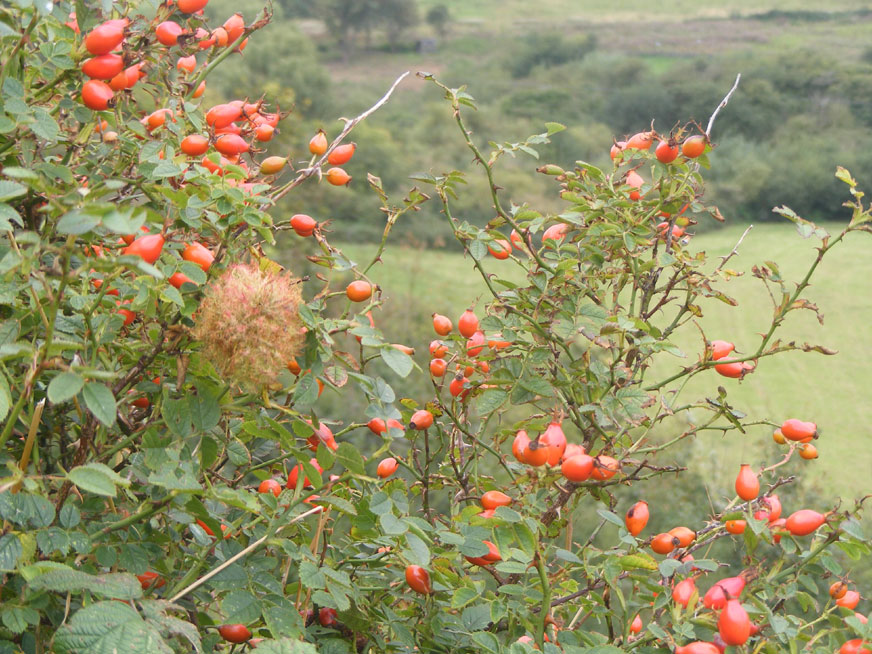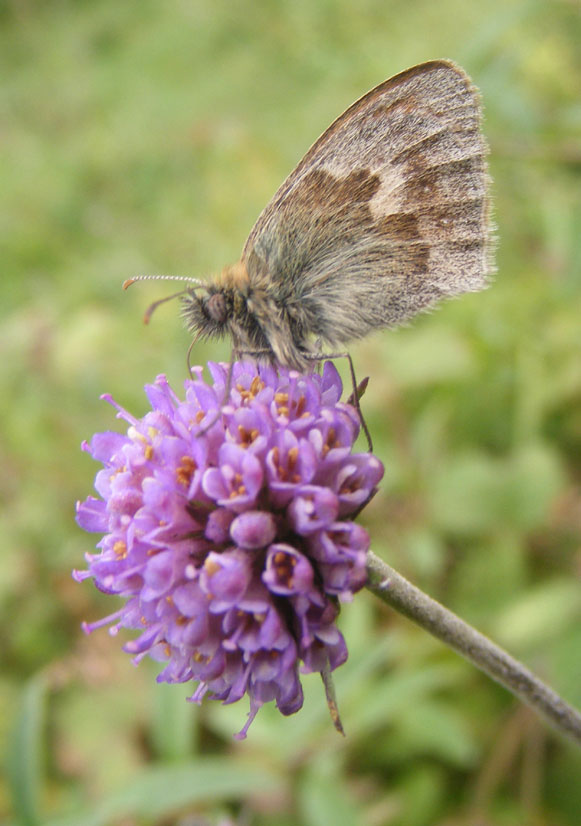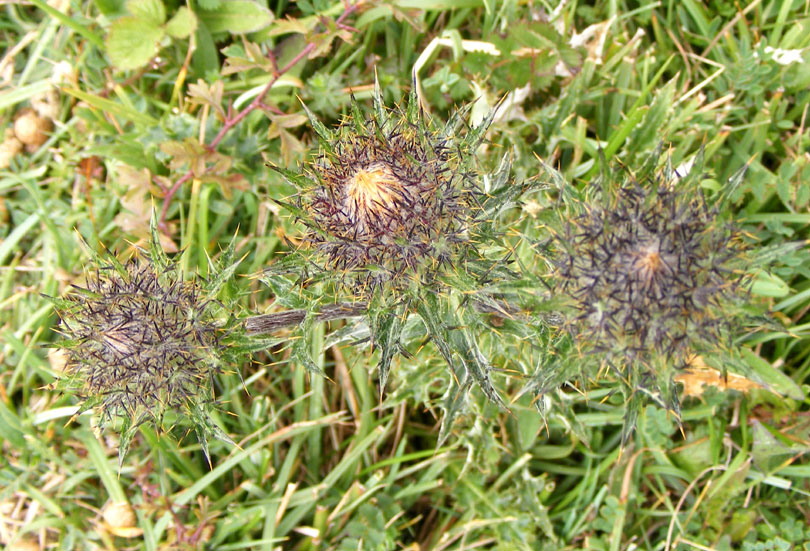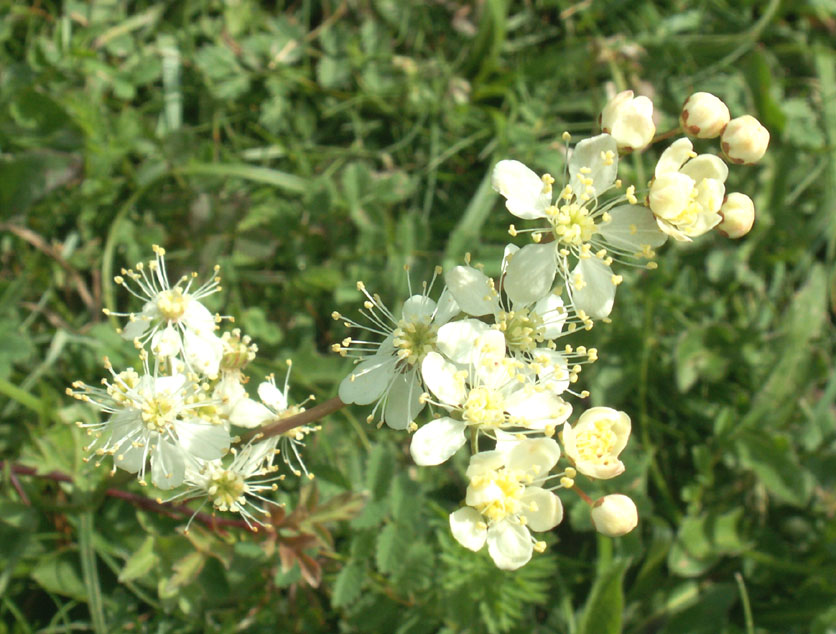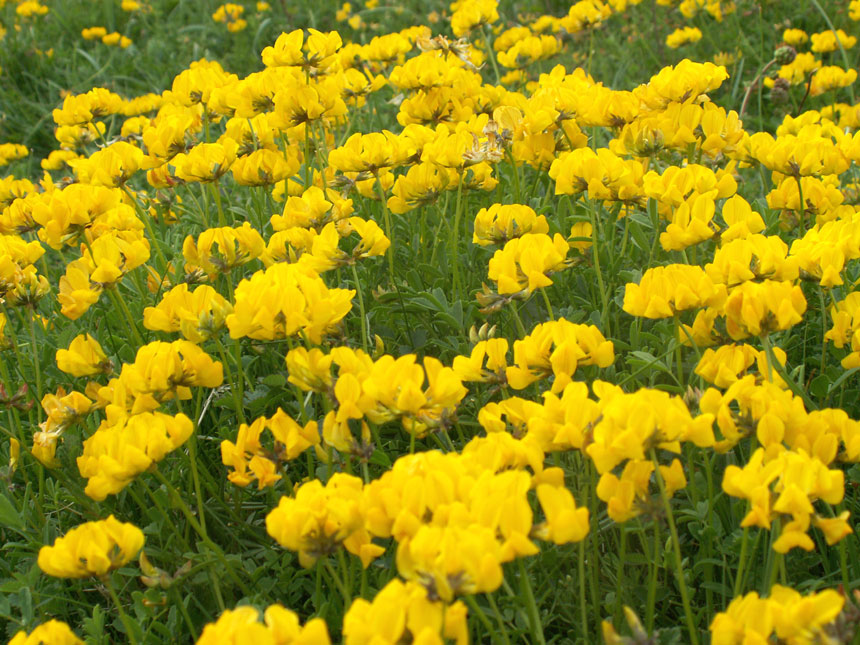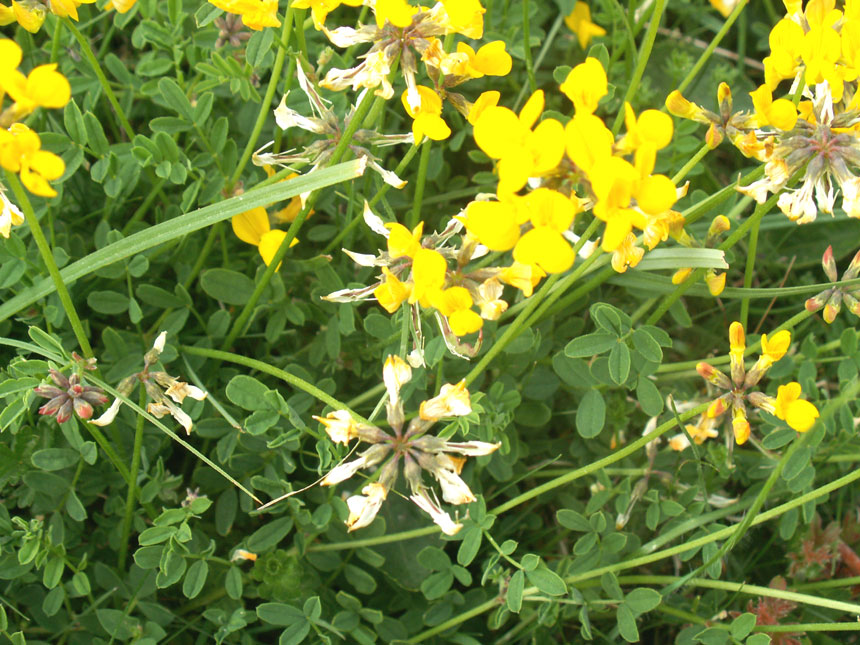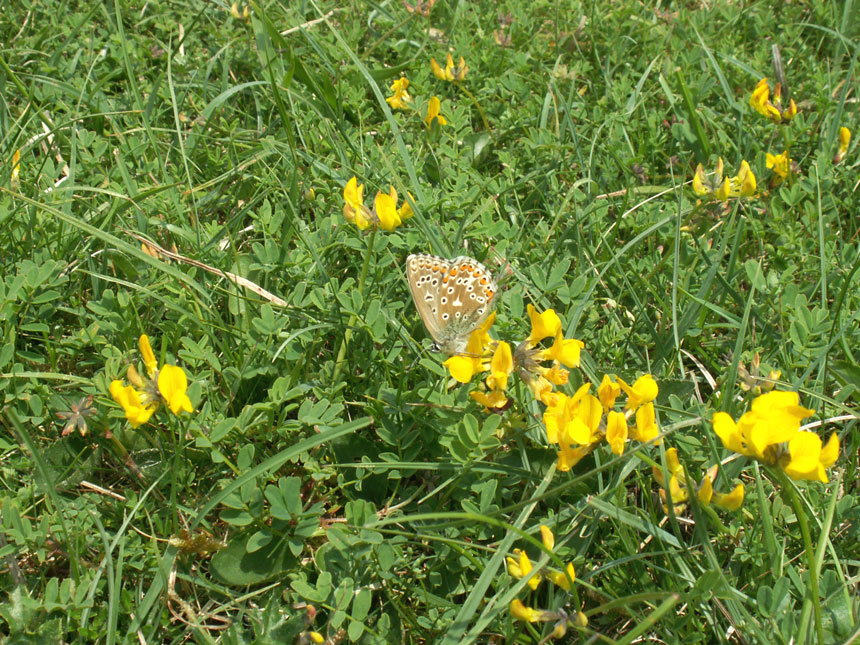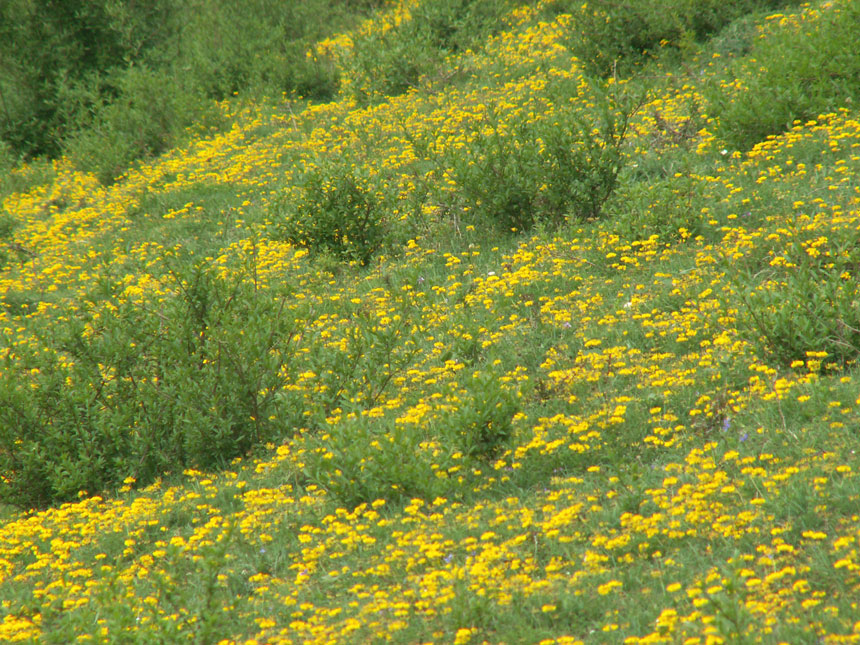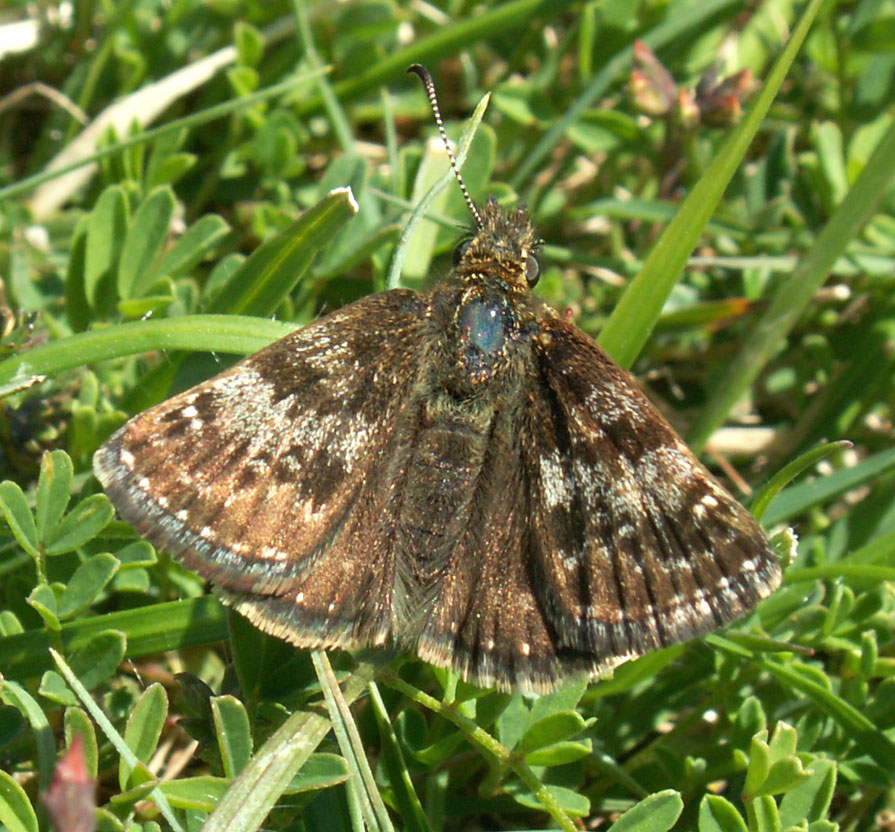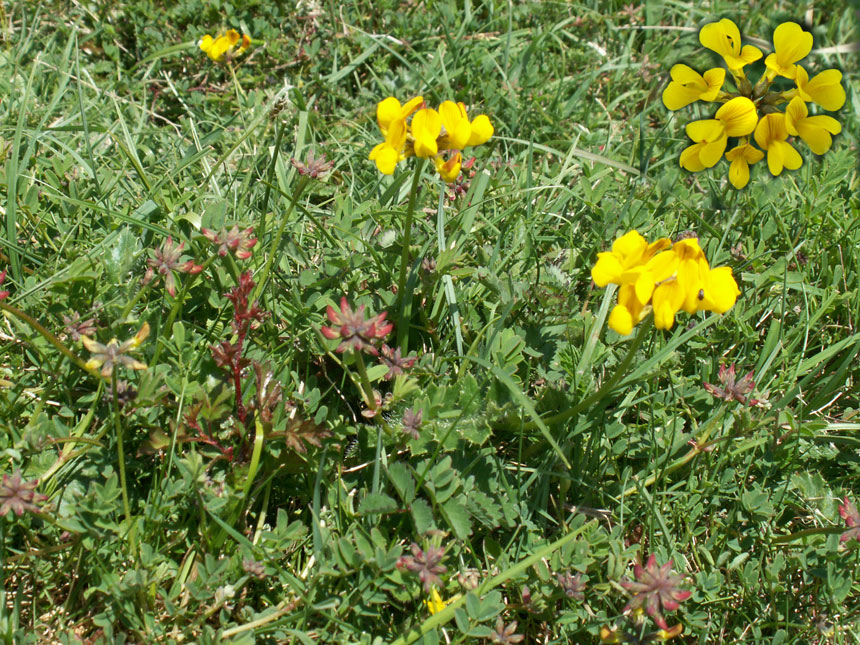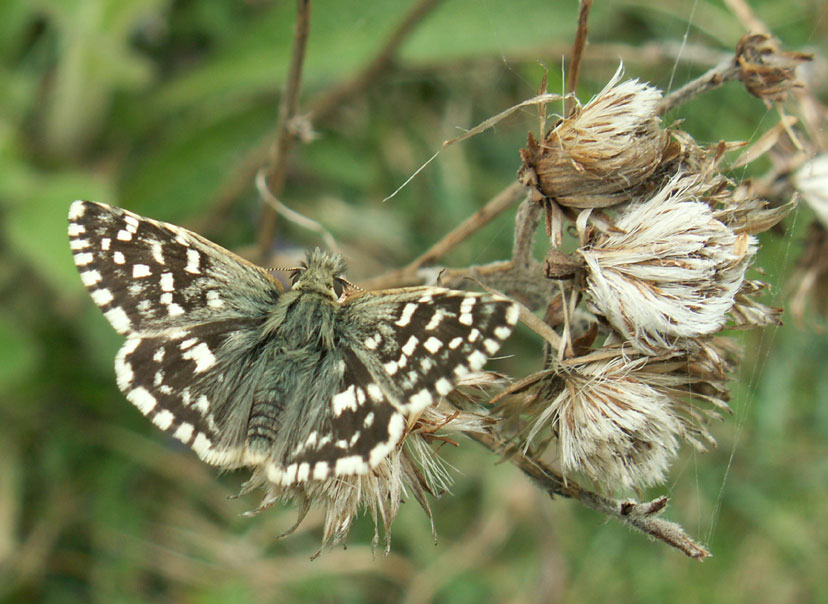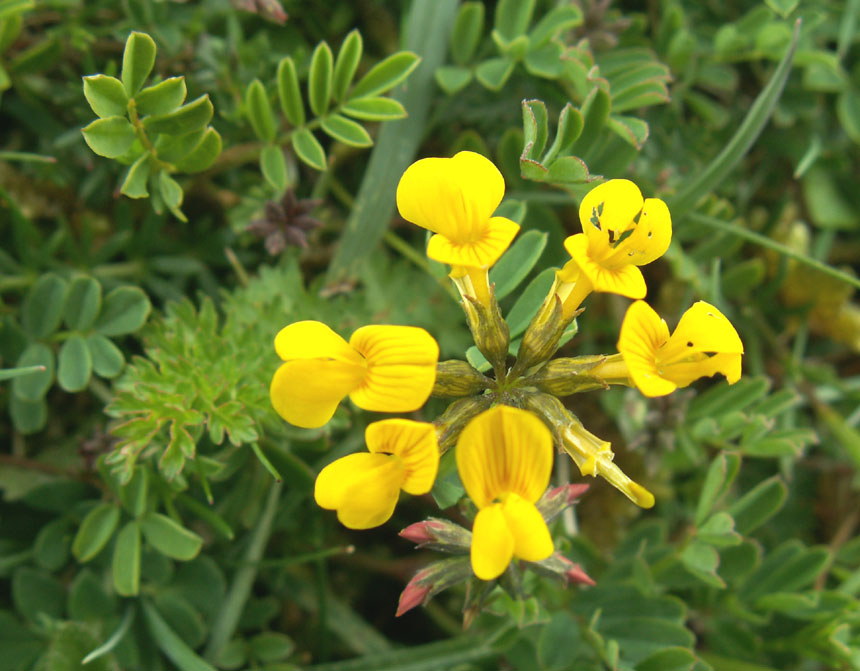-
 Lower
Slopes of Mill Hill 2008: The
Shoreham Bank
Lower
Slopes of Mill Hill 2008: The
Shoreham Bank
The
lower slopes of Mill Hill contains about 6.4
acres of open herbland (original chalkhill, pre-grazing ecology*), with
over six acres of a continuous carpet of Horseshoe
Vetch, Hippocrepis
comosa, mixed with other herbs,
sedges and grasses. Its greatest claim to fame is the large number (3000+
in a good year) of Chalkhill Blue Butterflies.
(* Chalkhill herbs develop before grass on chalk.)
My
transect route for recording butterflies
is 400 metres (default half-transect) and a total of 750 metres if I return
along the path (full transect). The half transect route covers 1.2 acres
of the best butterfly ground.
First
Draft of the Article for the Shoreham Society Newsletter
Representations
to the Local Adur Plan
Adur
Butterfly List 2006
Mill
Hill (lower slopes) Flora Images (technical)
Local
Nature Reserve Designation
Some
Indicator Plants of Ancient Downland

|

|

|

|
|
Horseshoe
Vetch
|
Common
Milkwort
|
Dog
Violet
|
Autumn
Gentian
|
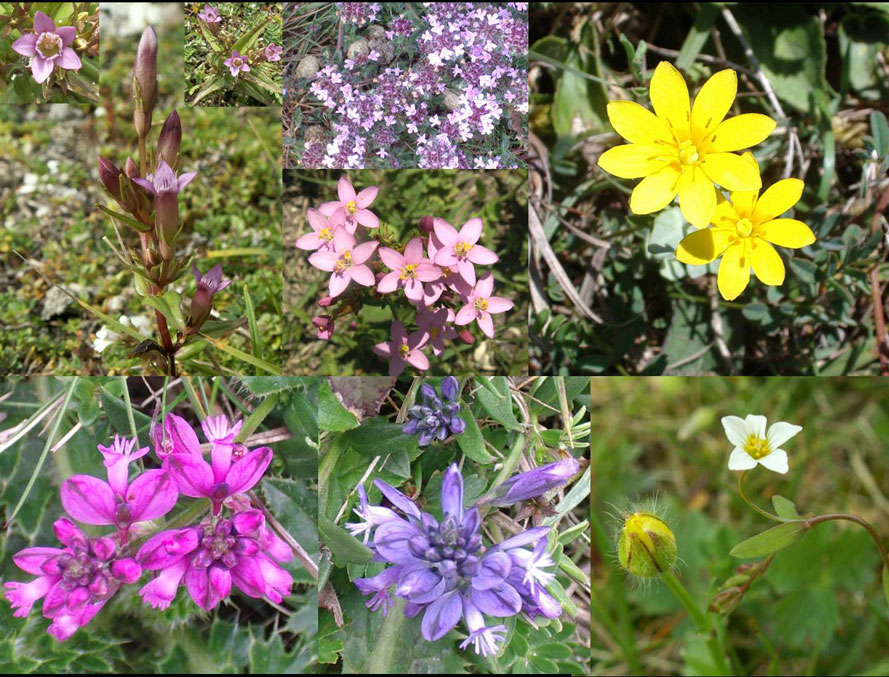 Other
indicators on the lower slopes include Dropwort,
Autumn
Ladies Tresses (upper plateau), Hairy
Violet,
all
of which are rarely found on pastures, restored wildlife meadows or agricultural
downland. Other downland plants that are more likely on the biodiverse
down herbland are Wild Thyme,
Carline
Thistle, Stemless Thistle, Squinancywort,
Fairy
Flax, Small Scabious,
Common
Centaury and
Wild
Basil. There are other more widespread
wild plants like the Mouse-eared Hawkweed,
Rough Hawkbits, Autumnal Hawkbit, Creeping Cinquefoil, Bird's Foot Trefoil,
Ground
Ivy, Germander
Speedwell, Field Speedwell, Scarlet Pimpernel,
Sweet
Violet,
Self-heal
and Yellow Wort
as well as many others.
Other
indicators on the lower slopes include Dropwort,
Autumn
Ladies Tresses (upper plateau), Hairy
Violet,
all
of which are rarely found on pastures, restored wildlife meadows or agricultural
downland. Other downland plants that are more likely on the biodiverse
down herbland are Wild Thyme,
Carline
Thistle, Stemless Thistle, Squinancywort,
Fairy
Flax, Small Scabious,
Common
Centaury and
Wild
Basil. There are other more widespread
wild plants like the Mouse-eared Hawkweed,
Rough Hawkbits, Autumnal Hawkbit, Creeping Cinquefoil, Bird's Foot Trefoil,
Ground
Ivy, Germander
Speedwell, Field Speedwell, Scarlet Pimpernel,
Sweet
Violet,
Self-heal
and Yellow Wort
as well as many others.
Wild
Flora and Fauna on Chalk flickr
Wild
Flowers 2008
WILDLIFE
REPORTS
Mill
Hill Reports 2009
16
November 2008
A
morning visit failed to produce anything noteworthy. Sheep
were feeding on the pasture to the west of Mill
Hill, in preference to the adjoining stubbled meadow.
12
November 2008
A
couple of Magpies
were seen feeding on a dead adult Rabbit
on the path. At least four freshly dead Rabbits
were seen plus the bones and decayed remains of another one. There were
no butterflies on the lower slopes and flowers
were limited to a few remnants of Hawkbits,
plus the dead heads of Carline Thistle on
their silver leaves. Sheep
were feeding on the stubble of the meadow below and to the west of Mill
Hill, when it appeared that the leading Sheep led the large flock into
the waterlogged pasture further west.
27
October 2008
There
were no butterflies seen in twenty minutes
before the forecasted cold weather. There
were very few nectar plants, one flower
of Devil's Bit Scabious,
one Autumn
Gentian, one Stemless
Thistle, a few bedraggled Hawkbits
and some Wild Basil.
After the rain, there was the expected patches of the algae Nostoc Commune.
The paths were muddy and slippery with an attempted rabbit burrow seen
by deposits of loose earth. The tight knitted herbs kept much of the slopes
intact. Privet
was in berry and this invasive native woody plant was expanding its range
and threatening to destroy the slopes for butterflies.
17
October 2008
A
midday visit to the
lower slopes of Mill Hill was leisurely.
There were hardly any butterflies, just one
plain brown Common Blue
female, one Small Copper
that appeared after five minutes and a few Meadow
Browns. There was only one flower
of Devil's Bit Scabious noted.
A few Vapourer Moths
took flight towards the bottom hedgerow.
Sheep
were grazing in the hay meadow immediately below (to the west of) Mill
Hill.
 12
October 2008
12
October 2008
A
late morning visit to the
lower slopes of Mill Hill was restricted
to about 30 minutes including the return trip by the shortest ridge route.
In the weak sunshine, the first butterfly
was a Large White
spotted from the steps flying strongly across the berried Privet
in the central area below the path. Simultaneously a Silver
Y Moth fluttered from almost under my
feet. A Small Heath Butterfly
also flew strongly up the slope. At the northern end there were two tattered
male Adonis Blues
and two male Common Blues seen
in the few minutes I was there. A fine condition Brown
Argus
visited
Wild Basil
and
Autumnal Hawkbit.
A
Rabbit
skull was lying on the bank.
Butterfly
Report
8 October
2008
After
five days of rain and poor weather the herb
layer of the lower slopes of Mill Hill
was still springy and firm under foot. A Peacock
Butterfly flew up and visited me.
Otherwise
all the butterflies were at the northern
end and there were not very many of them, a handful of Meadow
Browns, a tatty male Adonis
Blue, at least one good condition male
Common
Blue and a Small
Copper. A Buff-tailed
Bumblebee
climbed up a stalk of Devil's Bit Scabious. I observed a late Meadow
Grasshopper,
Chorthippus parallelus.
On
the lower slopes, I noted Yellow Wort,
Fairy Flax, Hawkbits, Self-heal, Common
Centaury and
Wild
Basil and I overlooked many other flowers
as I was not searching for them.
Adur
Butterfly List 2008
Adur
Bumblebees
Adur
Grasshoppers
2 October
2008
There
was the faint bite of an autumn chill in the air on a morning of weak sunshine,
and the butterflies did not emerge until
near midday. At the northern end of the lower slopes of Mill
Hill, three species could be seen resting on Devil's
Bit Scabious and only later when the sun
came out did many of the butterflies emerge in numbers and fluttered about
so much that I could not be sure of the numbers. Meadow
Browns were the first seen, counted at
least eight, and then I spotted a female Adonis
Blue with her wings closed on Devil's
Bit Scabious followed by a closed winged Small
Copper on the same plant.
Then
magically as it warmed up slightly, two Meadow
Browns began courting, two out of three Small
Coppers chased each other all over the bank,
more Adonis Blues
appeared with at least half a dozen of each gender, the females
in good condition and the males
mostly ragged and torn. A Large White
flew over the straggly hedgerow. In contrast, the Common
Blues were
ten minutes later to appear, with at least five males,
some in fine condition, with at least one brown female
identified. The last species on the lower slopes was a surprise
Brown Argus,
with at least five pristine individuals counted. The first plant of nectar
choice was Devil's Bit Scabious
which was also used as a roosting shrub. However, a Meadow
Brown visited Wild
Basil, a female Adonis
Blue visited a Hawkbit
and
a male Common
Blue settled on
a Hardhead.
I noticed at least one Stemless Thistle
still in flower. There were still millions of leaves of Horseshoe Vetch,
Hippocrepis
comosa, visible on the slopes.
Full
Butterfly Report
28
September 2008
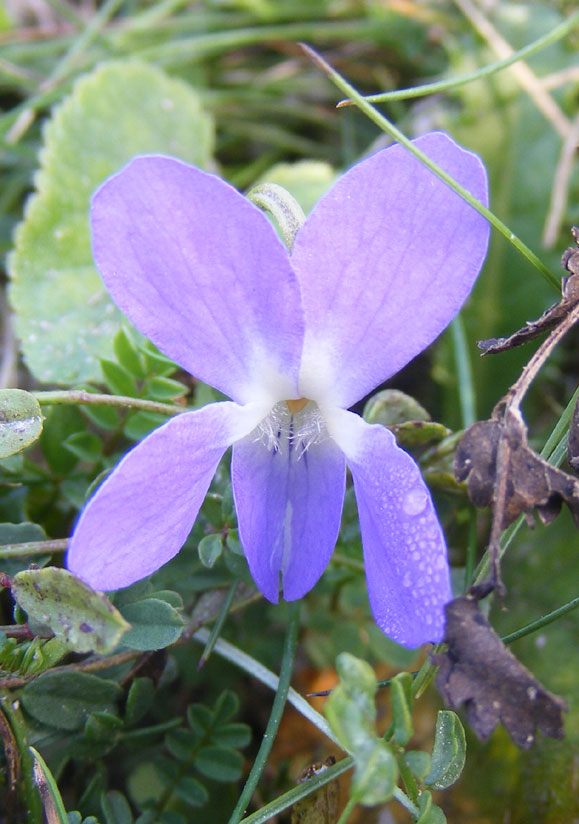 A
trek in the weak sunshine to the lower slopes of
Mill
Hill were initially devoid of
butterflies
and their numbers seen have fallen from last week with two Large
Whites, two male and one female Common
Blues,
six
Meadow Browns,
one Small Heath Butterfly
and just the one female Adonis Blue
spotted.
A
trek in the weak sunshine to the lower slopes of
Mill
Hill were initially devoid of
butterflies
and their numbers seen have fallen from last week with two Large
Whites, two male and one female Common
Blues,
six
Meadow Browns,
one Small Heath Butterfly
and just the one female Adonis Blue
spotted.
A
single flower of Sweet Violet
was noted are the southern end of the lower slopes.
Carline
Thistle was in all three forms, the dead
plants were grey including the leaves, the new growths have orange heads
and green leaves, but some of the orange heads were furring up and the
prickly leaves were turning brown.
Adur
Violets
Carline
Thistle Study
25
September 2008
A
Grass
Snake slid under a Privet bush is a depression on the lower slopes
of Mill Hill, but despite looking through
the Privet, I could not find out where it was hidden.
The
lower slopes of Mill Hill were initially devoid of butterflies,
but they then appeared in dribs and drabs, a Green-veined
White, a Small
Heath Butterfly and a Small
Copper on a pocket of Bramble
scrub in the middle of the Shoreham Bank below the winding path. As usual,
most of the butterflies were to be found
at the northern end, including at least eleven male Adonis
Blues, another Small
Copper, eight Meadow
Browns, another Large
White and one male Common
Blue.
There
were a handful of Common Darters
(dragonfly) around.
Full
Butterfly Report
Carline
Thistle Study
21
September 2008
 In
the weak sunshine, I recorded two or three male
Common
Blues
plus two females, 7-8 male Adonis Blues
plus 4-6 females, six Meadow Browns,
two Large Whites,
one Small Heath
and a Small Copper.
The difficulties over the numbers were caused because of the tattered condition
of the blue butterflies and the brown females, it was not possible to positively
identify all of them to species. Again the Devil's
Bit Scabious at the northern end proved
to be a major attractant of over half the recorded total of the blue species
and Meadow Browns
and the solitary Small Copper.
In
the weak sunshine, I recorded two or three male
Common
Blues
plus two females, 7-8 male Adonis Blues
plus 4-6 females, six Meadow Browns,
two Large Whites,
one Small Heath
and a Small Copper.
The difficulties over the numbers were caused because of the tattered condition
of the blue butterflies and the brown females, it was not possible to positively
identify all of them to species. Again the Devil's
Bit Scabious at the northern end proved
to be a major attractant of over half the recorded total of the blue species
and Meadow Browns
and the solitary Small Copper.
16
September 2008
I
was not in the mood to monitor butterflies
on an overcast day, but on the lower slopes of Mill
Hill, I noted five Meadow Browns,
two Wall Browns,
thirteen Adonis
Blues
(three females), three Common Blues
(one female) and a faded Pyrausta nigrata
moth.
12
September 2008
Adonis
Blues on Devil's
Bit Scabious
On
the lower slopes of Mill Hill, the first
butterfly seen was Common Blue,
followed later by a female of the species, a few male Adonis
Blues
scattered over the slopes with a congregation of both sexes on the Devil's
Bit Scabious at the northern end, totalling
seven males and seven females, plus six Meadow
Browns (gender undetermined, mostly males),
two Small Heath Butterflies,
at least one Treble-bar Moth
and a faded Pyrausta nigrata.
9 September
2008
It
was still much too overcast, with spots of rain, for butterflies
to be out and about if they had survived the atrocious weather.
A quick check on the Privet-inundated
lower slopes of
Mill Hill produced seven
male Adonis Blues,
ten Meadow
Browns and a Small
Heath Butterfly. There were no Chalkhill
Blues seen. Devil's
Bit Scabious was seen in flower for the
first time this year.
Adur
Butterfly List 2008
4 -
7 September 2008
There
was more atrocious weather with heavy rain
intermittently on all four days.
15
August 2008
After
four days of poor weather, the butterflies
were out again. They were common on the lower slopes
of
Mill Hill with 25+ Chalkhill
Blues
including
a few females,
62 male Adonis Blues,
an estimated 75+
Meadow
Browns
of
both sexes, frequent Common
Blues
(estimated
12+) including very small ones, one confirmed
Gatekeeper,
a few Large Whites,
at least one Green-veined White,
two Speckled Woods on
the southern steps, and a Wall Brown.
Full
Butterfly Report
10
August 2008
A
second brood Dingy Skipper fluttering
around in the herb undergrowth at the the northern end of the lower
slopes of
Mill Hill was difficult to
spot on a day on a day too breezy for the flowers to remain still enough
to photograph. (This skipper
may have been around for a week or more.)
I had to virtually to tread on many of the blue butterflies
to make them take flight so the numbers recorded were low: 26+ Chalkhill
Blues
including
a few females, 48+ Adonis
Blues (with no females discerned),
and frequent
Common Blues
(estimated
20+) with almost as many females
as males. Occasional Chalkhill Blues
of both sexes were worn and ragged.
Meadow
Browns
(estimated 50+) were the most frequent butterflies
with
both males and females in roughly equal numbers. A Wall
Brown paid me a visit when I attempted
to photograph a collection of mixed blues
on a live Carline Thistle
waving frantically in the wind.
Gatekeepers
were recorded at just three, one Green-veined
White settled for identification out of
two and there was a Large White
by the hedgerow. The small pyralid
moth,
Pyrausta
purpuralis seen on the lower slopes.
Unusually I retraced my steps along the return path of the lower slopes
and added another Chalkhill Blue
and five more Adonis Blues.
Full
Butterfly Report
6
August 2008
With
the weather conditions ameliorated enough to make a trip to Mill
Hill worthwhile, it seemed as though I have missed the main emergence
of Chalkhill Blue
Butterflies for 2008
as the very poor showing of 43 (with one female) on the 1.2 acre transect
on the lower slopes indicated. There were nearly as many fresh male Adonis
Blues with 37 noted on the lower slopes,
not to be confused with Common Blues,
including six on the lower slopes. A total of nine Brown
Argus Butterflies
were recognised on Mill Hill with six of these occurring over the lower
slopes. Mill Hill hosted frequent
Gatekeepers
and
Meadow
Browns.
Wall
Browns appeared in the front of me on
one occasion and a Marbled White
was a welcome surprise over the lower slopes of Mill Hill.

|

|

|
Pyrausta
purpuralis Moth
on
Mill Hill
|
Male
Adonis
Blue 2nd brood
on
Mill Hill
|
Carline
Thistle
|
Two
of the small
Small Heath Butterflies
settled. The small pyralid
moth,
Pyrausta
purpuralis seen on the lower slopes.
At least three Treble-bar Moths
were fluttering around at the northern end. White
butterflies were seen by the hedgerow, but
they were too far away to identify. There were occasional Green-veined
White Butterflies.
Fleabane
was noted on some disturbed ground for the first time, but it did not seem
to be thriving in the low fertility soil. Its flowers had not opened.
Full
Butterfly Report
|
Chalkhill
Blues
The
maximum transect day count for 2008
was 81 on 30 July 2008,
which was even lower than 2007
when the maximum 1.2 acre day count was 96 on 5
August 2007. In 2003,
the Chalkhill Blues
were too many to count and the estimate for the 1.2 acre transect was at
least 375 and possibly double that. |
 |
1 -
5 August 2008
It
was too breezy and overcast to assess the Chalkhill
Blues on Mill
Hill.
30
July 2008
 The
Chalkhill
Blues were slow to appear this year, as
the count of a mere 81 (including two females) plus two male Adonis
Blues on the lower slopes of
Mill
Hill, indicated. There were a handful of Common
Blues
of both sexes noted. The usual Gatekeepers
and
Meadow
Browns
were
present.
The
Chalkhill
Blues were slow to appear this year, as
the count of a mere 81 (including two females) plus two male Adonis
Blues on the lower slopes of
Mill
Hill, indicated. There were a handful of Common
Blues
of both sexes noted. The usual Gatekeepers
and
Meadow
Browns
were
present.
The
most interesting lepidopteran
observation were the frequent occurrence of a small brownish moth
on the
lower slopes of
Mill
Hill. At least twenty flitted about in a five metre square patch.
This
was Synaphe punctalis,
a pyralid moth associated with shingle and sand
dunes as well as other dry habitats such as chalk downland. Not a common
species, but it seems to have spread its range in Sussex in recent years.
The larvae feed on mosses.
The flash
of grey was a Treble-bar Moth.
Full
Butterfly Report
28
July 2008
A
second brood male Adonis Blue
was identified on the lower slopes of Mill
Hill and one was seen there yesterday as well. My visit was to look
for the main emergence of Chalkhill Blues
and make a count on the 1.2 acre transect of the lower slopes, which came
to 68 males. There were frequent Gatekeepers
and
Meadow
Browns
everywhere,
and at least one Small Heath
on the lower slopes of Mill Hill.
Full
Butterfly Report
27
July 2008
On
warm (21.5 °C)
sunny day, the number of Chalkhill Blues
on
the lower slopes was counted at 48 (with just one female noted in tandem
with a male in flight). The first
butterfly
seen was a Brown
Argus.
There were six Common Blues
(including one female), one Brimstone Butterfly,
plus occasional Gatekeepers and
Meadow
Browns.
The large white butterflies in the distance could have been Large
Whites or Brimstones.
The small pyralid moth,
Pyrausta
nigrata was noted and a few Six-Spot
Burnet Moths.
Full
Butterfly Report
25
July 2008
Unfortunately
the Chalkhill Blues
numbers continue to disappoint on Mill Hill.
Also of note was a second brood Dingy Skipper
on the lower slopes.
23 July
2008
A
check of the lower slopes of Mill Hill
revealed 34 Chalkhill
Blues
(including two females). The day was sunny but the period spent on the
1.2 acre transect of the lower slopes was overcast by passing clouds and
the blue butterflies
were mostly resting and a third of the ones in flight were disturbed. (The
count would have expected to be higher if the sun was out.) There
were not many other butterflies on the lower
slopes either with just nine Gatekeepers,
two
Meadow
Browns
and
one Large White.
Tabular
List
Adur
Butterfly List 2008
Full
Report
|
|
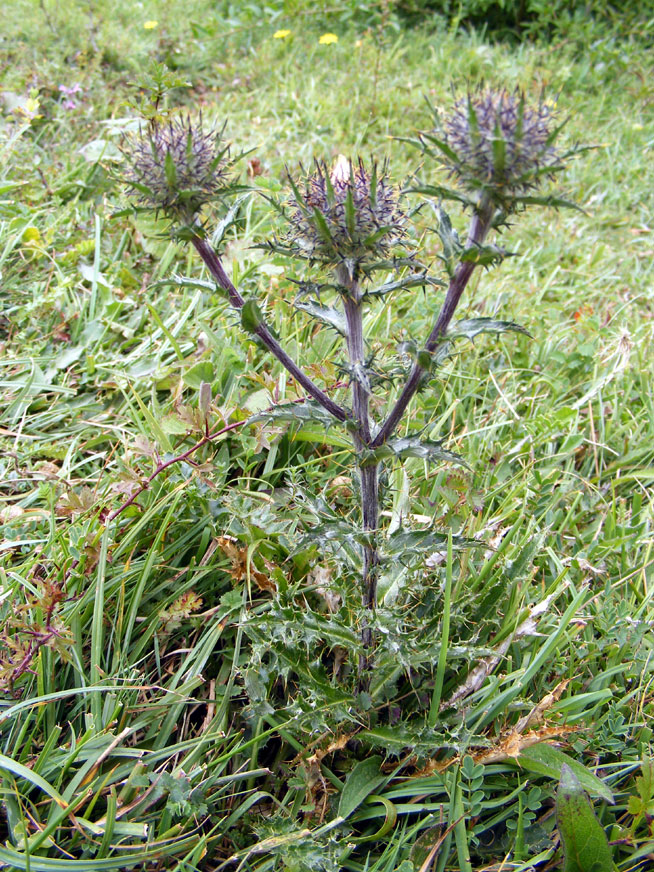 |

July
2008
In
this study of Carline Thistle
we see the old dead plants still in place as the new growths first appear
on the lower slopes of Mill Hill.
|
Adur
Thistles
20
July 2008
The
Chalkhill
Blue count was 17 (including one female)
on an acre of the lower slopes. Other butterflies
recorded on the Shoreham Bank were four Gatekeepers,
two Meadow
Browns,
one Large White and
a Peacock Butterfly.
The small pyralid moth,
Pyrausta
nigrata was frequently seen, with
some of them much more faded than others. There was one Pyrausta
purpuralis moth.
A
Sweet
Violet was noted in flower.
Adur
Violets
15
July 2008
Chalkhill
Blues were just beginning on Mill Hill
with 23 strong flying males noted on the lower slopes. I noted just the
one Meadow
Brown,
but there was likely to be many more, frequent
Gatekeepers,
especially in the Tor Grass
area, two Large Whites,
one Brimstone Butterfly,
one Marbled White
which settled with its wings closed, and a Small
Heath Butterfly.
The
small pyralid moth,
Pyrausta
nigrata was occasionally seen, with
some of them much more faded than others. There were probably many more
that went unnoticed.
Full
Butterfly Report
Chalkhill
Flowers 2008
13
July 2008
On
rather dull day, I arrived at Mill Hill
about 11.45 am,
the sun had disappeared behind a cloud for the whole duration of my stay
of about 45 minutes. Not surprisingly the butterfly tally was low: frequent
Gatekeepers,
occasional
Meadow
Browns,
two Chalkhill Blues
(including one female), one Marbled
White, one Small
White (could have been a Green-veined
White?) and one Small
Skipper on the lower
slopes, plus another Burnet Moth.
The small pyralid
moth,
Pyrausta
nigrata was frequently seen on the
lower slopes. Most of them were so faded that they were originally mistaken
for one of the other pyralids. The silvery dead plants of last year's Carline
Thistle were still prominent.
Full
Butterfly Report
 11
July 2008
11
July 2008
Blustery
conditions (Force 5
gusting to Force 6), but at least the rain
held off: a few butterflies were in flight,
another two Chalkhill Blue Butterflies
flew over the lower slopes of
Mill Hill,
with occasional Gatekeepers,
and a Large White. The
small pyralid moth,
Pyrausta
nigrata was frequently seen on the
lower slopes of Mill Hill in the afternoon. Most of them were so faded
that they were originally mistaken for one of the other pyralids. One of
the Chalkhill Blues
settled very briefly on a Self-heal
flower. Stemless Thistle
was observed in flower for the first
time this year. Hawkbits
were very common and these are both the Autumnal
Hawkbit and Rough
Hawkbit were noted for the first time.
Vervain
bordered
the paths and Lady's Bedstraw
and Eyebrights
and Wild Basil
were flowering on the bank.
Adur
Butterfly List 2008
Adur
Thistles
6-10
July 2008
Four
days of continual gales and heavy rainfall prevented any visits to Mill
Hill. On the fifth day the planned trip
was interrupted by a heavy rain shower.
5 July
2008
The
first two Chalkhill Blue Butterflies
flew over the lower slopes of
Mill
Hill, late in the afternoon. They may
have been in flight for a few days as the first report from Sussex
of this butterfly
was on 1 July 2008.
The
first
Small Purple-barred Moth,
Phytometra
viridaria, of 2008
was seen on the lower slopes of Mill Hill. The late afternoon time, about
4:30
pm, would explain the paucity of butterflies,
just the one Small Heath Butterfly,
four Marbled Whites,
at least two Large Whites
and half a dozen Meadow
Browns
on
a passage visit.
Full
Butterfly Report
29
June 2008
Great
Mullein and the much smaller Vervain
were seen in flower for the first time this year and the first Robin's
Pin Cushion on the lower slopes of
Mill
Hill. On a late afternoon too breezy for butterflies,
I managed to spot just one Small Heath
immediately,
an unexpected (they should have ceased in mid-June)
pristine male Adonis Blue,
a male and female Common Blue,
a Marbled White and
a
Meadow
Brown.
Full
Butterfly Report
22
June 2008
The
first grasshoppers were seen and heard on the lower slopes of Mill
Hill, with my first definite sightings of two Marbled
White Butterflies blown about in the Force
6 gusting to Gale
Force 8. One male and one worn female Common
Blue
Butterfly, three Small
Heath Butterflies, and just a single male
Meadow
Brown
Butterfly
were also seen.
Full
Butterfly Report
 Squinancywort
was seen in flower for the first time
this year. Perforate St. John's Wort was
also noted in increasing amounts. This plant usually establishes in disturbed
soil and can be in invasive nuisance if its spread gets out of hand. Hawkbits
and Wild Thyme
were prominent on the slopes with Yellow
Wort, with occasional Dropwort,
patches of Bird's Foot Trefoil and
Common
Centaury noted.
Squinancywort
was seen in flower for the first time
this year. Perforate St. John's Wort was
also noted in increasing amounts. This plant usually establishes in disturbed
soil and can be in invasive nuisance if its spread gets out of hand. Hawkbits
and Wild Thyme
were prominent on the slopes with Yellow
Wort, with occasional Dropwort,
patches of Bird's Foot Trefoil and
Common
Centaury noted.
19
June 2008
A
Large
Skipper was seen clearly on the lower
slopes amongst the Brambles and Tor Grass, with four Common
Blues
including one female, and seven Small Heath
Butterflies
on a day that was too breezy
and cool for the butterflies to make a decent
showing.
A
particular attractive specimen of the bumblebee-mimic Volucella
bombylans
var. plumata hoverfly
was noted and it was unfortunate that my camera was broken.
Perforate
St. John's Wort was beginning to flower
in a few isolated plants on the lower slopes (this
plant is apt to be invasive on disturbed soil),
open flowers of Yellow Wort
were frequent in the late morning, and noted amounts of Bird's
Foot Trefoil, Fairy
Flax, Common
Milkwort, Common Centaury, Wild Thyme and
rather less than expected only occasional Dropwort.
Adur
Wild Flowers 2008
Full
Butterfly Report
6 June
2008
My
first Large Skipper
of the year looked very fresh and quite lively on the lower slopes of Mill
Hill, but one of the two Dingy Skippers
was very dingy and worn. The lower slopes produced 16 Adonis
Blues
on passage over the transect 1.2 acre area, including three females, six
Common
Blues
including two females, and two Small Heath
Butterflies. A few of the distinctive
Panorpa
flies
were seen amongst the flowering
Privet.
Full
Butterfly Report
Adur
Skippers
Dropwort
was just beginning to flower.
1
June 2008

Any hint
of sun had faded on my arrival on the lower slopes of Mill
Hill, where the Horseshoe Vetch,
Hippocrepis
comosa, had rapidly faded and 23 Adonis
Blues (including just one female seen)
stood
out against the green appearance of the slopes, with two Yellow
Shell Moths seen early on amongst the
Wild
Privet, two Small
Heath Butterflies, and one Common
Blue Butterfly. A further Small
Heath Butterfly was spotted as I returned
rapidly by the ridge route. I recorded Wild
Thyme for the first time this year. A
few Yellow Wort
flowers were closed at 1:00 pm.
The Privet was growing back strongly from where it had been cut
down.
The
characteristic dipping flight of a Yellowhammer
was
seen over the lower slopes.
Full
Butterfly Report
Adur
Butterfly List 2008
Full
Wild Flower Report
24
May 2008
Mill
Hill: In windy conditions we managed to see perhaps 30 Adonis
Blue,
including a few females, and three Common
Blues on the lower slopes along with a
couple of Brimstone Butterflies
and a Lesser Treble-bar Moth.
There was also a single
Wall Brown
at the north west corner of the reserve on the path that leads to Old Erringham
Farm.
19
May 2008
 An
early afternoon visit to Mill Hill in slightly
cool (12.6 °C)
conditions with a 15 minute ramble over the 1.2 acre transect area of the
lower slopes produced 36 Adonis
Blue
Butterflies
of
which three were females,
six Small Heath Butterflies,
one Dingy Skipper,
three Grizzled Skippers,
one unidentified white butterfly,
one Pyrausta nigrata pyralid
moth,
and two Treble Bar Moths. The male
Adonis
Blues were sparring with three seen together
twice, but there were no observed matings. I looked for Common
Blues without success (making me think that
the ones a few days ago could have been misidentified
Adonis
Blues?).
An
early afternoon visit to Mill Hill in slightly
cool (12.6 °C)
conditions with a 15 minute ramble over the 1.2 acre transect area of the
lower slopes produced 36 Adonis
Blue
Butterflies
of
which three were females,
six Small Heath Butterflies,
one Dingy Skipper,
three Grizzled Skippers,
one unidentified white butterfly,
one Pyrausta nigrata pyralid
moth,
and two Treble Bar Moths. The male
Adonis
Blues were sparring with three seen together
twice, but there were no observed matings. I looked for Common
Blues without success (making me think that
the ones a few days ago could have been misidentified
Adonis
Blues?).
The
occasional yellow Hawkweed-type
flowers were examined for their leaves
and on the open bank amongst the abundant
Horseshoe
Vetch,
Hippocrepis
comosa, the species Lesser
Hawkbit, Leontodon saxatilis, was
provisionally identified, and next to the path at the northern end before
it entered the scrub, Mouse-eared Hawkweed
was
located. The Horseshoe Vetch
had a higher proportion of finished flowers than five
days ago, about 15%, but the covering
was still extensive.
Adur
Butterfly List 2008
Hawkweed
Species List
Shoreham
Pilosella
Study
14
May 2008
A
late afternoon visit to Mill Hill was undertaken
for the purpose of ascertaining the extent of the covering of Horseshoe
Vetch,
Hippocrepis
comosa, which could be seen from Old
Shoreham by the Toll Bridge. It was
at least as spectacular as the best year, but a close inspection revealed
that a proportion (c 5%) of the flowers
were already fading on the lower slopes.
|
|
 |
Although,
it was too windy, too cool and too late in the day for butterflies,
a couple of enthusiasts said they had given up counting the Adonis
Blues
at
over a hundred over a three acre area of the lower
slopes. I recorded my first Common
Blue Butterfly* of the year. I found
Adonis
Blues to be frequent on the lower slopes,
Common Blues
occasionally spotted (they were
difficult to distinguish from the male Adonis
Blues). A few Grizzled
Skippers and a few Dingy
Skippers were still in flight amongst
the Horseshoe Vetch.
A couple of Speckled Woods were
seen, one by the bottom hedge of the lower slopes and another amongst the
scrub.
(*
I am having second thoughts about the ID. It was not a Holly
Blue.)
Adur
Butterflies: First Dates
Adur
Butterfly List 2008
9 May
2008
I
was two days late on parade to see my first Adonis
Blue
Butterflies
of
the year on the lower slopes of Mill Hill.
One of the three looked very much like a brown female
with its wings closed and without the distinctive blue as it flew off.
I also saw five of my first Small Heath
Butterflies of the year four on the lower
slopes and one on the ridge return route. There was one Wall
Brown that flew high up into the hedgerow,
one male Brimstone Butterfly, one
Green-veined
White, eleven Dingy
Skippers and four Grizzled
Skippers.
The
Horseshoe
Vetch,
Hippocrepis
comosa, was visible from a
distance but still a week off its best showing.
The
Pyrausta
nigrata pyralid
moths
were occasionally seen and many were missed. There was a probable Pyrausta
despicata
pyralid as well, but it eluded a photograph.
7 May
2008
Two
Adonis
Blue
Butterflies (including an atypically early female!), one Common
Blue, two Small
Heath, three Wall
Browns and Dingy
and Grizzled Skippers
were plentiful at Mill Hill. The
blues were both the first of the year.
Adur
Butterflies: First Dates
Adur
Butterfly List 2008
6 May
2008
Horseshoe
Vetch,
Hippocrepis
comosa, was much more prominent
on the lower slopes of Mill Hill and could
be seen covering the lower slopes before I descended the steps at the southern
end. The unusual observation compared to previous years was the early flowers
at the northern end were much reduced compared to previous years. Dog
Violets were very common and Milkwort
was
all over the slopes.
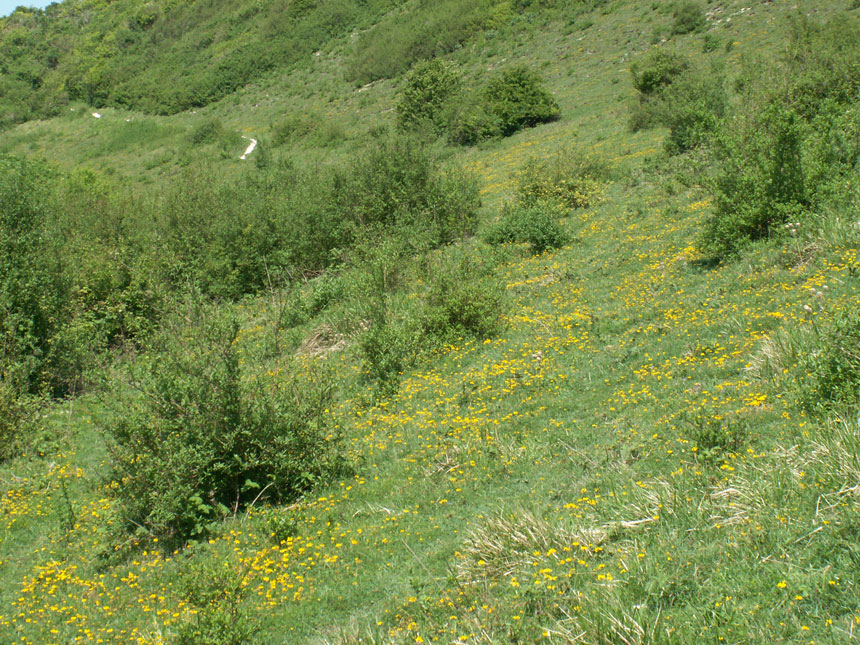
|

|
 |
|
The
beginnings of he flowering Horseshoe
Vetch on the lower slopes of Mill Hill
|
Horseshoe
Vetch on the Mill Hill Cutting
|
Horseshoe
Vetch on Mill Hill
|
11
Grizzled
Skippers, about 12
Dingy
Skippers (one on the middle slopes) and
at least five Pyrausta nigrata pyralid
moths
were seen on the lower slopes.
Adur
Butterfly List 2008
2 May
2008
On
a mild sunny day, 13.2 °C, between
two and four (one could have been seen three times) Peacock
Butterflies were seen over the lower slopes
of Mill Hill. Five Grizzled
Skippers were seen on a leisurely (30
minutes) passage trip over the lower slopes visiting the very common Horseshoe
Vetch,
Hippocrepis
comosa, and common Milkwort
flowers
and landing on Bramble leaves, but none on the common Dog
Violets and Daisies.
Two of the Grizzled Skippers appeared
to be courting.
Two
Dingy
Skippers were spotted. At least two Pyrausta
nigrata pyralid
moths,
the first small Pyrausta
purpuralis pyralid moth
of
2008,
and
a fluttering
Treble Bar Moth were
noted. At least one Red-tailed Bumblebee,
Bombus
lapidarius, was very active.
Adur
Butterfly List 2008
Adur
Bumblebees
29
April 2008
I
went to Mill Hill
and actually found some sun between showers (12.15
-2.15 pm). On the lower
slopes were two Large
Whites and a Peacock.
Just about to give up and trudge back up the hill when I saw my first ever
Grizzled
Skipper.
27
April 2008
With
spots of rain and a relatively cool 13.8 °C,
the butterflies remained moribund in the
morning. On the lower slopes, I disturbed just one Small
Tortoiseshell, discovered two Grizzled
Skippers, one resting on a tall dead plant,
one Pyrausta nigrata pyralid
moth,
and a good condition Peacock Butterfly.
A
Treble-bar
Moth,
Aplocera
sp. was spotted resting.
Dog
Violets and Horseshoe
Vetch, Hippocrepis
comosa, were common and other frequent
plants in flower included Dandelions
and Common Milkwort.
25
April 2008
The
first Dingy Skipper
of 2008 was seen
on the lower slopes of Mill Hill around
midday.
One Grizzled Skipper was
also spotted on a passage journey with a return route via the ridge.
A
birdwatcher reported seeing five Grizzled
Skippers.
Adur
Skippers
Three
Small
Tortoiseshells and a worn Peacock
Butterfly were recorded on a muggy day.
The photographed
Small Tortoiseshell
visited three Dog Violets
in succession. The first Sphaerophoria
scripta hoverflies
were seen visiting Daisies
on the lower slopes of Mill Hill around
midday.
Adur
Butterflies: First Dates
Adur
Butterfly List 2008
20
April 2008
 Two
Partridges
whirred over the lower slopes from the shelter of the lower unruly hedgerow/scrub.
A few Long-tailed Tits
were seen in the Blackthorn
scrub on the northern edge of the steep slopes above the path.
Two
Partridges
whirred over the lower slopes from the shelter of the lower unruly hedgerow/scrub.
A few Long-tailed Tits
were seen in the Blackthorn
scrub on the northern edge of the steep slopes above the path.
The
first Green-veined White Butterfly
of the year was seen over the path by the flowering Blackthorn
leading into scrub at the northern end of the lower slopes of Mill
Hill. Frequent Peacock Butterflies
numbered at least a dozen over the lower slopes of Mill Hill. A passage
journey over the lower slopes of Mill Hill revealed four Grizzled
Skippers visiting Dog
Violets and at least one of the first Pyrausta
nigrata pyralid
moths
of 2008.
On
the lower slopes of Mill Hill, the first Horseshoe
Vetch, Hippocrepis
comosa, was seen in flower
with the accompanying pollen beetles, Meligethes
erichsoni.
Adur
Butterflies: First Dates
Adur
Butterfly List 2008
 13
April 2008
13
April 2008
The
first Common Milkwort of
the year was seen in flower.
13
April 2008
There
were three other butterfly enthusiasts (Andrew
Burns, Neil Hulme and Bert Laker) on the lower
slopes of Mill Hill in the afternoon, chasing
around the Grizzled Skippers
until they stopped for a photograph. I saw three of them, but Andrew
Burns reported at least ten different ones
(ignoring possible doubles, twenty sightings in total) along the whole
of the lower slopes below the path. Both males and females were reported.
Other butterflies on the lower slopes were
just the one Peacock
and a Small Tortoiseshell.
There
were frequent micro-moths amongst the ground herbs.
They were a pale grey or fawn colour.
 |
 |
The
Dog
Violets were prevalent, as well as Sweet
Violets in thousands scattered over the
slopes. They seemed to be in fewer numbers than previous years. One clump
of Cowslips
were noticed. A Bee-fly
over the slopes was not identified to species. A Red-tailed
Bumblebee,
Bombus lapidarius,
was only the second seen this year and the first on Mill Hill.
Adur
Skippers
Adur
Bumblebees 2008
Adur
Violets
10
April 2008
On
a mild (>10.5 °C)
sunny day on the southern end steps down to the lower slopes of Mill
Hill, a Peacock Butterfly rested.
This was followed by four more
in flight together, followed by another two resting and two in the scrub
in the north-west of Mill
Hill Nature Reserve. My first Grizzled
Skipper of the year fluttered in front
of me and then jousted with another of the same species. In the Hawthorn
as the path enters the scrub to the north a Comma
Butterfly was seen.
Violets
did not seem as many as in previous years, but there were still thousands
of Sweet Violets
on the lower slopes and some Dog Violets.
Adur
Butterflies: First Dates
Adur
Butterfly List 2008
6 April
2008

A surprise
April
snowfall
throughout
the morning (9:00 pm to 12:30 pm)
left snow to a depth of 100+ mm
on Mill Hill,
drifting to much deeper in places.
Full
Report
Shoreham
Weather Page 2008
5 April
2008
Mill
Hill SMG Meeting
Despite
the awful forecast and plummeting temperature the first SMG evening field
meeting of the year at Mill Hill near Shoreham
was well attended. However, we only saw three moths
- but nobody was complaining; two were of our target species: Barred
Tooth-striped Moth, Trichopteryx
polycommata, and the other
was the micro Pale Flat-body,
Agonopterix
pallorella.
Adur
Moths
26
March 2008
Four
Peacock
Butterflies were seen in under an hour
on the downs north of Shoreham, the first
faded specimen at the top of the Pixie Path
to Mill Hill, the second and third left the lower slopes of Mill
Hill, and the fourth one was in the extreme north-west
corner of Mill Hill Nature Reserve next to
the Old Erringham pasture. Thousands of Sweet
Violets were in flower
scattered over the lower slopes and at least one
Dog
Violet was identified (by its white spur
and pointed sepals) amongst them.
Adur
Butterfly List 2008
Adur
Violets
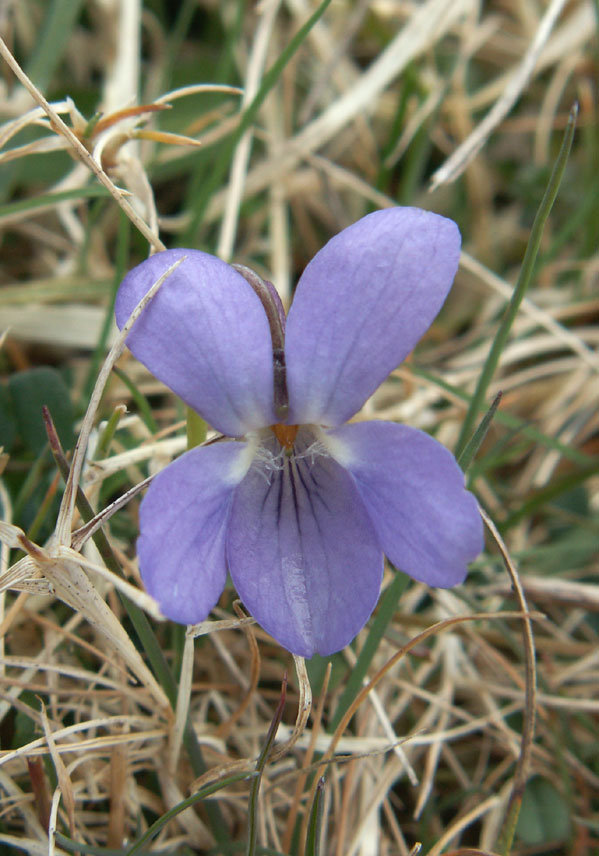
9 March
2008
A
Partridge
took flight from the lower slopes and flew over the hay meadow to the west.
Hundreds of Sweet Violets
were now to be seen flowering on the lower slopes of Mill
Hill. There was a patch of brown Nostoc
commune. A few leaves of Horseshoe
Vetch, Hippocrepis comosa,
were noticeable and the silver leaves and dead heads of Carline
Thistle.
27
February 2008
Frequent
Sweet
Violets were now to be seen flowering
on the lower slopes of Mill Hill. A Dandelion
was the only other flower apart from the silvery leaves and dead heads
of Carline Thistle.
The leaves of Horseshoe Vetch, Hippocrepis
comosa, could now be seen if looked for.
Adur
Violets
18
February 2008
| This
is the ridge path referred in some of the text. On the left (west) of the
image are the steep tops of the lower slopes of Mill
Hill. In the middle distance you can just
about see the farmhouses of Old Erringham and in the far distance
the downs on the western side of the river.
The scrub is shown encroaching especially in the north-west
of Mill Hill Nature Reserve.
If
you click on the picture, the view is of the usual return route looking
south-east towards the Reservoir. |
 |
A chirping
flock of about nine Meadow Pipits
settled for about five minutes on a Hawthorn
bush on the lower slopes of
Mill
Hill before flying off to another bush. The remains of a Wood
Pigeon and scattered feathers were observed
in an open area. The most likely predator was a Fox
(although
the Stoat is
a possibility?).
There
was one cow pat
on the lower slopes and another on the steep slope below the ridge (part
of the lower slopes). There was another cow
pat on the steps leading down to the lower
slopes which were so muddy that walking boots were advisable.
Cattle
Damage on Mill Hill Report
10
February 2008
Around
midday
a a vanessid butterfly
rose from the lower slopes of
Mill Hill
and fluttered further up the slope so I had to chase it to identify the
good condition Peacock Butterfly
when it basked briefly in the weak sunshine with its wings open.
This
was the second of two of the first February
records on these Nature Notes pages for the Peacock
Butterfly, making four species seen in the
second month of the year.
The
leaves of the Horseshoe Vetch, Hippocrepis
comosa, were not showing, but layers of moss
were seen occasionally.
Adur
Butterfly Flight Times
Adur
Butterflies: First Dates
Mill
Hill (lower slopes) Flora Images (technical)
January
2008
The
Shoreham Bank too muddy and slippery to visit for the whole of the month
and any sliding about on the steep lower slopes would have caused unacceptable
disturbance and erosion, as well as being hazardous.
Lower
Slopes (Shoreham Bank) 2007
Lower
Slopes (Shoreham Bank) 2007
Mill
Hill 2007
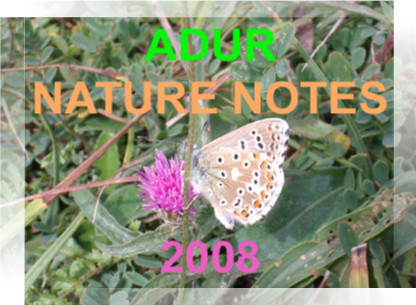
Technical
Flora Images Mill Hill Lower Slopes
 Lower
Slopes of Mill Hill 2008: The
Shoreham Bank
Lower
Slopes of Mill Hill 2008: The
Shoreham Bank

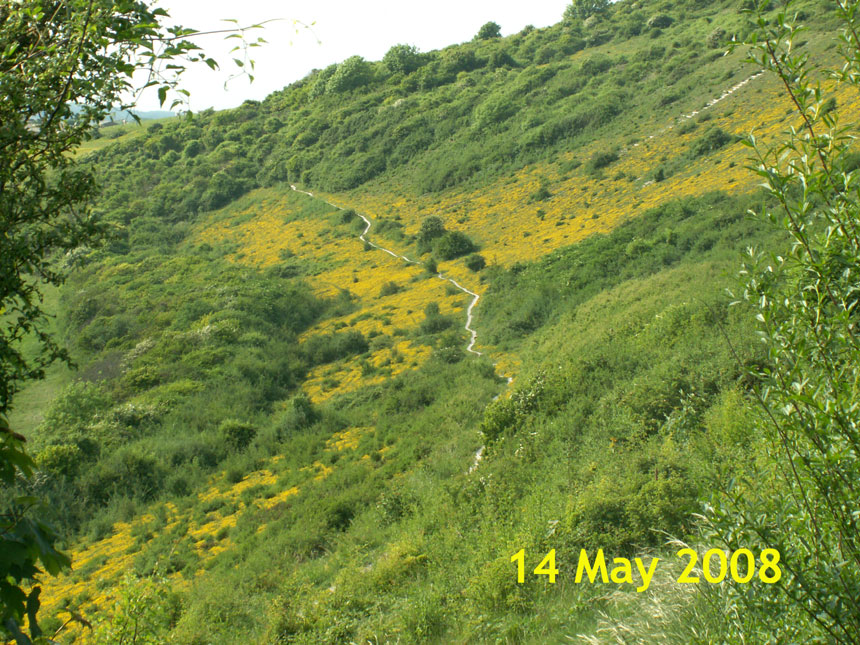










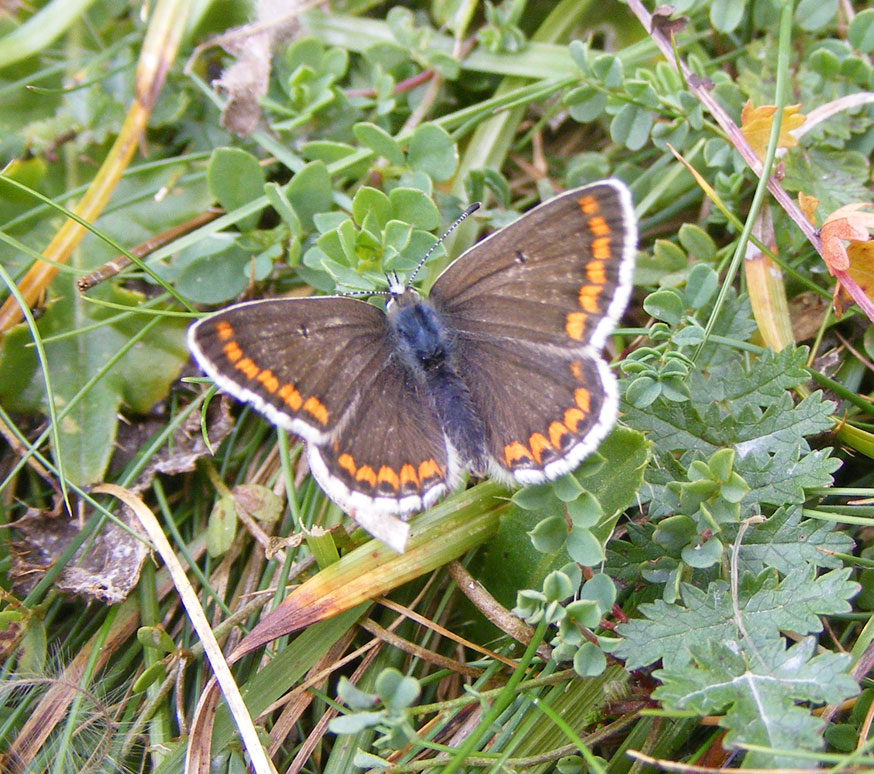





 In
the weak sunshine, I recorded two or three male
Common
Blues
plus two females, 7-8 male Adonis Blues
plus 4-6 females, six Meadow Browns,
two Large Whites,
one Small Heath
and a Small Copper.
The difficulties over the numbers were caused because of the tattered condition
of the blue butterflies and the brown females, it was not possible to positively
identify all of them to species. Again the Devil's
Bit Scabious at the northern end proved
to be a major attractant of over half the recorded total of the blue species
and Meadow Browns
and the solitary Small Copper.
In
the weak sunshine, I recorded two or three male
Common
Blues
plus two females, 7-8 male Adonis Blues
plus 4-6 females, six Meadow Browns,
two Large Whites,
one Small Heath
and a Small Copper.
The difficulties over the numbers were caused because of the tattered condition
of the blue butterflies and the brown females, it was not possible to positively
identify all of them to species. Again the Devil's
Bit Scabious at the northern end proved
to be a major attractant of over half the recorded total of the blue species
and Meadow Browns
and the solitary Small Copper.



